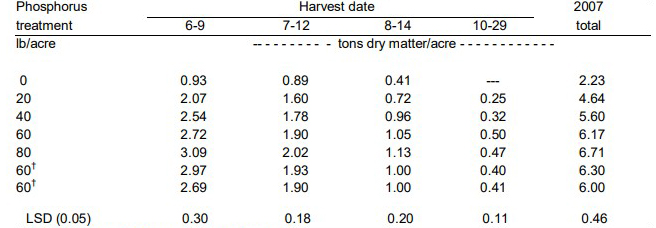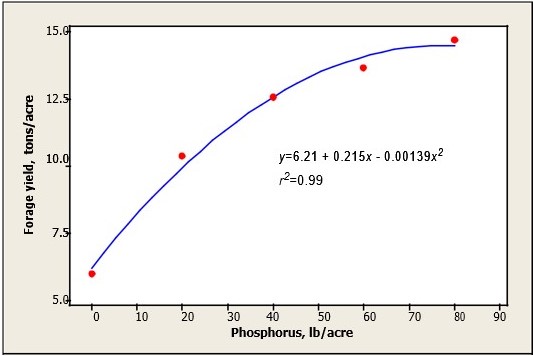Phosphorus Fertilization of Alfalfa in 2006 to 2008
Dwain W. Meyer and Robert Nudell (posted December 2008)
Productivity of alfalfa may be limited by a nutrient deficiency. Potassium is the nutrient that is most often needed in alfalfa, but in North Dakota, many soils test quite high (300 to 700 lb/acre) in potassium and does not need to be applied to obtain high yields of alfalfa. Phosphorus is typically the most limiting nutrient for alfalfa productivity in North Dakota. The objective of this experiment was to determine the yield loss associated with lack of phosphorus fertilization on a soil testing 2 ppm (4 lb/acre) phosphorus.
Phosphorus treatments (given in Table 1) were applied in the fall of 2005 as ammonium phosphate (11-52-0) to an old stand (4 years) of alfalfa at Buffalo, ND. The plots were laid in the field utilizing a randomized complete-block design with four replicates. Forage was harvested with a flail harvestor at the late bud stage in the first harvest and nearly 80% bloom in the next two harvests since the height of the forage was only 10 to 17 inches. The harvest plot was 38 inches wide by 25 feet. Dry matter samples were taken on each plot and dried at 120oF until dry.
Forage yields for the three harvests and the season in the first year of fertilization are presented in Table 1. Forage yield increased with increasing phosphorus rate up to 60 lb P/acre for the season. Adding sulfur or a foliar micronutrient (Max-In) fertilizer did not affect productivity. Forage yields in 2006 were reduced by inadequate rainfall, almost no rainfall during June and July. Had more normal rainfall occurred, the forage yields would have been much higher, forage yields in 2005 averaged nearly 6 tons/acre on this same site. Therefore, the full potential for phosphorus fertilization was not reached in 2006.





